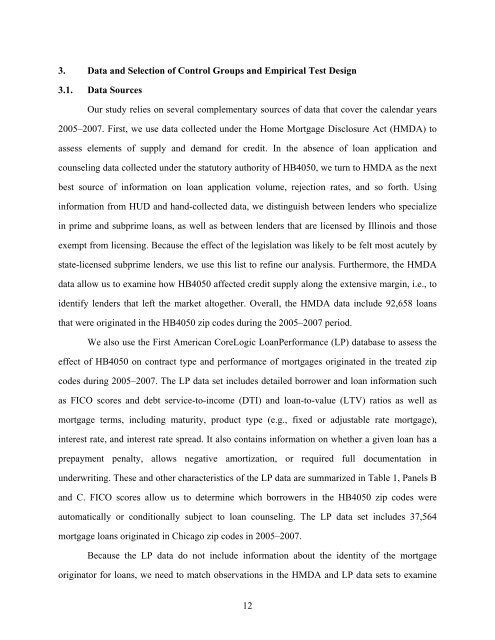Create successful ePaper yourself
Turn your PDF publications into a flip-book with our unique Google optimized e-Paper software.
3. Data and Selection of Control Groups and Empirical Test Design<br />
3.1. Data Sources<br />
Our study relies on several complementary sources of data that cover the calendar years<br />
2005–2007. First, we use data collected under the Home Mortgage Disclosure Act (HMDA) to<br />
assess elements of supply and demand for credit. In the absence of loan application and<br />
counseling data collected under the statutory authority of HB4050, we turn to HMDA as the next<br />
best source of information on loan application volume, rejection rates, and so forth. Using<br />
information from HUD and hand-collected data, we distinguish between lenders who specialize<br />
in prime and subprime loans, as well as between lenders that are licensed by Illinois and those<br />
exempt from licensing. Because the effect of the legislation was likely to be felt most acutely by<br />
state-licensed subprime lenders, we use this list to refine our analysis. Furthermore, the HMDA<br />
data allow us to examine how HB4050 affected credit supply along the extensive margin, i.e., to<br />
identify lenders that left the market altogether. Overall, the HMDA data include 92,658 loans<br />
that were originated in the HB4050 zip codes during the 2005–2007 period.<br />
We also use the First American CoreLogic LoanPerformance (LP) database to assess the<br />
effect of HB4050 on contract type and performance of mortgages originated in the treated zip<br />
codes during 2005–2007. The LP data set includes detailed borrower and loan information such<br />
as FICO scores and debt service-to-income (DTI) and loan-to-value (LTV) ratios as well as<br />
mortgage terms, including maturity, product type (e.g., fixed or adjustable rate mortgage),<br />
interest rate, and interest rate spread. It also contains information on whether a given loan has a<br />
prepayment penalty, allows negative amortization, or required full documentation in<br />
underwriting. These and other characteristics of the LP data are summarized in Table 1, Panels B<br />
and C. FICO scores allow us to determine which borrowers in the HB4050 zip codes were<br />
automatically or conditionally subject to loan counseling. The LP data set includes 37,564<br />
mortgage loans originated in Chicago zip codes in 2005–2007.<br />
Because the LP data do not include information about the identity of the mortgage<br />
originator for loans, we need to match observations in the HMDA and LP data sets to examine<br />
12

















